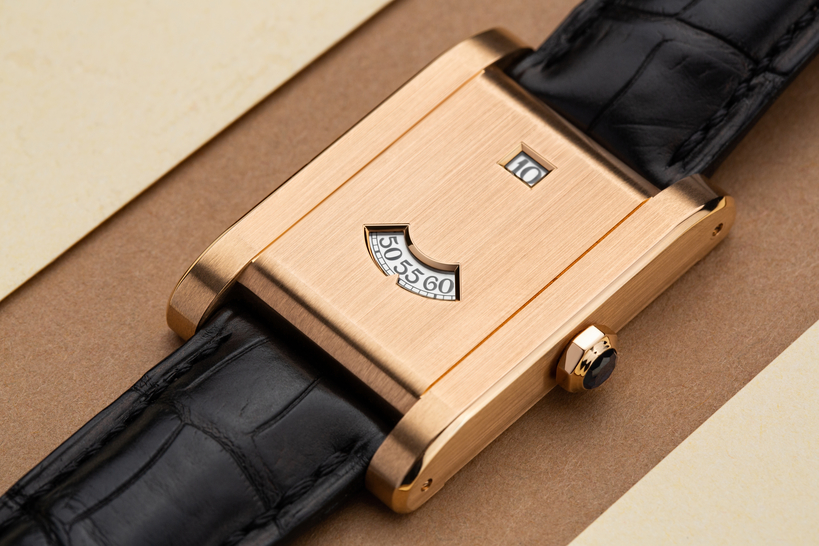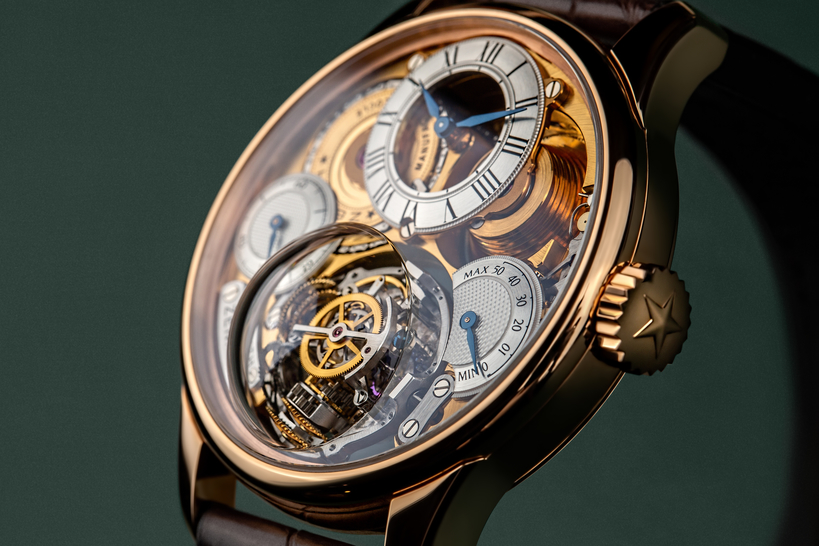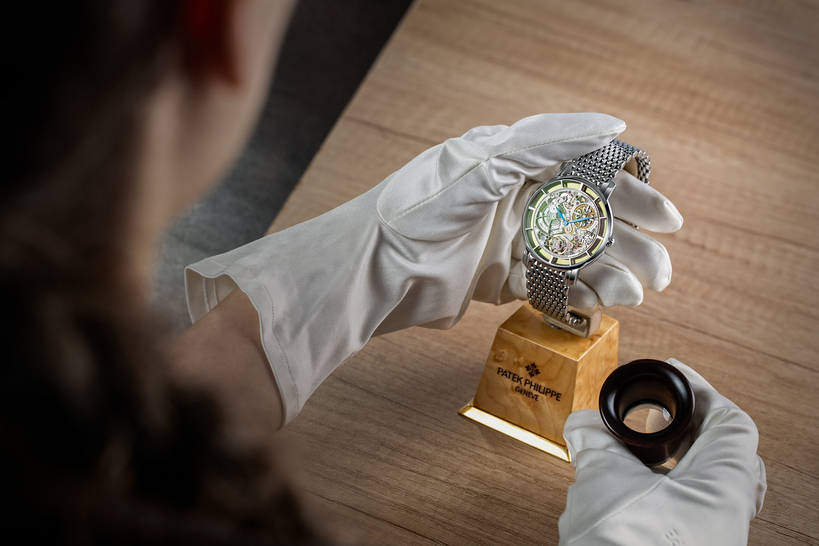Here are the new names which undeniably hold great potential.
There is much the industry can learn from the example set by 33-year old Albanian master watchmaker Rexhep Rexhepi and author of the Chronomètre Contemporain, which won the Men's Watch Prize at the Grand Prix d’Horlogerie de Genève (GPHG) in 2018.
Not too long ago, he was still a little-known cabinotier, but now he has become a collector's favorite and a name in major auctions, who collectors and experts have given a warm reception. His ascent to the Olympus of watchmaking, has inspired many young watchmakers. The question is whether any of them will succeed in following in his footsteps t achieve the same level of success.
Right now, only one thing is clear: there is no shortage of followers eager to get there. There were at least a couple of dozen concepts and prototypes at last year's Baselworld watch and jewelry show that boasted a great deal of promise. This year's events were all called off due to the coronavirus pandemic, but thanks to the information space we all share, better known as the internet, everyone is in with a chance to succeed no matter where in the world you live — be it in Geneva, Tokyo or a remote village somewhere in Europe.
The luxury watch industry's "baby boom" only seems to be unexpected and badly timed. On the contrary, it makes perfect sense. Major watchmakers are reducing the scale of their production output and putting extravagant and costly projects on hold, not to mention their long-term developments. In these circumstance, it is often the case that the young and up-and-coming newbies on the watchmaking scene simply don't get enough support, who are plunged into the deep end to go it alone, and only have themselves to rely on.
The most obvious criteria were used to compile a list of promising newcomers:
- they debuted in 2019 or later
- they have an original and promising idea
- they’ve created their own movements (it's not that hard to have a go at design if you've already got a standard caliber that can be sourced by anyone)
- the case and caliber have been presented properly.
This doesn't have to be on the same level as Patek Philippe, Vacheron Constantin or A. Lange & Söhne, but it should still be acceptable.
Following the Precepts of the Breguet
Apart from the renowned school of watchmaking in La Chaux-de-Fonds, there is another institution that offers professional training for aspiring watchmakers called Lycée Polyvalent Edgar Faure in Morteau, a town in eastern France. Independent watchmaker Rexhep Rexhepi has clearly made quite an impression on its graduates. After all, this article focuses on the work of three graduates from the same Lycée: Théo Auffret, Rémy Cools and Cyril Brivet-Naudot.
It is also likely that the art and legacy of great Swiss master watchmaker Abraham-Louis Breguet is taught very well at the Lycée Edgar Faure watchmaking school, who spent almost all his life working at the French royal court. That's the impression you get looking at the work of the three budding watchmakers, which all bear a strong resemblance to Breguet's pocket watches.
Théo Auffret won the Young Talent Competition in 2018, which was held as part of the Baselworld watch expo. His Tourbillon à Paris remained consigned to his long-term plans for a quite some time, as Auffret was kept busy with restoration work on 18th-19th century watches (he began to work on many of these pieces while still a student), along with his work at Ateliers 7h38, where the sensational Jacob & Co Astronomia was born. It happens to be the same atelier where Auffret helped create something truly special, the highly complicated Astronomia Maestro Minute Repeater.
His schedule did finally free up, and his plan to create the Tourbillon à Paris began to come to life. Once he had received some orders, Auffret decided to release 20 pieces. The Tourbillon à Paris is a regulator with no dial, in a style reminiscent of the famous Breguet Tradition collection.
The watchmaker has made the tourbillon components, mainspring barrel and subdial with hands indicating the time in three circles of equal proportion, which come together to form a kind of equilateral triangle. Moreover, the tourbillon carriage bridges and the mainspring barrel that hang over the movement's main plate are fitted with trademark shock-resistant Breguet pare-chutes.
The Tourbillon à Paris is a regulator with no dial, in a style reminiscent of the famous Breguet Tradition collection
The width of the huge tourbillon carriage is impressive, and let's not forget, the larger the balance wheel, the greater the the watch's potential precision. The frequency of the balance is a classic 18 000 vph. The precise rotation of the one-minute tourbillon carriage is balanced by seven massive laterally-mounted weights on the tourbillon carriage for poising. Auffret has fashioned the 38 mm case in platinum, gold and silver. The material of the case has little bearing on the watch's price tag, which cost around 110 000 euro per piece.
Auffret built each part of the movement from what he deemed to be most suitable: the barrel and a few wheels have been borrowed from the Peseux 260 movement, and the escapement has been taken from LeCoultre pocket watches. However, Théo Auffret deserves to be praised for creating most of the components himself, indeed by hand. He even decided against using computer graphics to shape the parts, which he drew using only good old pen and pencil on drawing paper. This is what gives his work its main edge, and it's also what makes it unique.
Everything has been done as it would have been back in the 17th-18th century, in a Swiss alpine village blanketed in snow and cut off from the rest of the world. Certain parts have been bought or bartered from neighbors, but the majority have been hand-crafted. Orders are still being taken: https://auffret-paris.com/.
The Free-Sprung Eccentric Chronometer
Cyril Brivet-Naudot is another artisan watchmaker who prefers working without any modern electronic equiptment, who also graduated from the famous École Polytechnique Fédérale de Lausanne after Auffret. In his short career, the young watchmaker has already been recognized with awards from François-Paul Journe and A. Lange & Söhne. Not only does the Eccentricity watch have an unusual way of indicating the time with an unusually built movement, but you could also say it has invented a new kind of escapement.
The free-sprung balance which runs at a frequency of 18 000 vph, along with the rotating disk which indicates the minutes have been mounted over the plate of the original hand-finished movement on Breguet pare-chutes. Moreover, the free-sprung balance wheel and escapement split between the front and back of the movement's plate.
The minutes are indicated by the teardrop-shaped blued steel pointer positioned under the arc-shaped plate with the brand name. The minute ring mounted on a transparent sapphire disk rotates while the drop remains stationary. The small subdial indicating the hours does not rotate independently. It travels with the sapphire disk on which it is also fixed.
This piece's main achievement is its spring détente escapement, with the spring discretely hidden under the plate of the movement
This piece's main achievement is its spring détente escapement, with the spring discretely hidden under the plate of the movement, although it has been made based on the escapement created by a well-known watchmaker of the past, Louis Richard (1812 – 1875), who specialized in producing marine chronometers. Brivet-Naudot has named it escapement "libre excentrique", or free eccentric escapement. Up to that point, the only person who had managed to create a détente escapement for wristwatches was the master watchmaker Christophe Claret.
And even that watch could only tentatively be called a chronometer. Thus, Brivet-Naudot's the free eccentric escapement is much closer to the escapements used in stationary marine chronometers, which achieved marvelous precision in spite of the monstrous conditions at sea in which they were used, which inevitably involved rocking, a high humidity, and extreme variations in temperature and in the electromagnetic field.
Another of this watch's unique features is its original construction with no winding crown. The watch is wound by a two-sided winding key, which fits into a square slot in the caseback. Just below the slot for winding is a second one for setting the time using the other end of the key. It's better to leave the key at home for safekeeping. The movement has a power reserve of 40 hours.
Brivet-Naudot has fashioned the watch's 39 mm case from steel. The watchmaker is taking pre-orders, and customization is available on request. Prices for his Eccentricity start at 60 000 euro The watchmaker can be contacted through his website: brivet-naudot.com.
A Tourbillon for Subscribers
The youngest of the three graduates of the Edgar Faure School is Rémy Cools, who just celebrated his 23rd birthday this year. He very recently presented his first finished and fully completed tourbillon timepiece — the Tourbillon Souscription. The word "souscription" can be translated from French as "subscription". In other words, you sign up to a subscription program to make a down payment and pay for the order (85 000 euro), and the watchmaker gets to work on your watch.
The face of the watch is dominated by a subdial at 12 o’clock with hour and minute hands, and a huge one-minute tourbillon at 6 o’clock. They are also equal in size at just under 16 mm, both mounted on the movement on shock-resistant Breguet pare-chutes. Cools has worked a sizable amount of the movement's components by hand. The design of the balance wheel, equipped with four regulating masses, was an idea he came up with himself.
The 7 mm thick sapphire crystal covering the dial is what gives the watch its rather unusual appearance. This is all the more striking, given that the watch's steel case is only 40 mm wide, with a slender 15 mm profile, and is reminiscent of the domed shape that was popular a couple of centuries ago. The domed crystal looks even more pronounced without a winding crown.
Cools has worked a sizable amount of the movement's components by hand
That's all down to the most curious little detail: two winding crowns (it would be more accurate to call them flip-up keys) have been integrated into the transparent sapphire caseback. We are already familiar with this invention, and it is one we are very fond of using — the keyless winding crown devised by Jean-Adrien Philippe in 1844, which could be used for both winding and setting the correct time. Before this invention, each watch came with a pair of keys for performing these actions separately. Keys were of course easy to loose, and this was their main drawback.
That's why Philippe's crown was met with such great applause. But now Cools has taken us back to the good old days, who has found another way to save us from going through all that bother with keys. In any case, all complicated clockwork ultimately requires a particularly delicate approach, and splitting these two crutial crown functions simplifies the construction, and should make it more reliable. The hand-wound movement ensures a power reserve of 36 hours, with a typical frequency for pocket watches of 18 000 vph.
Cools finished the laudably decorated case and the movement by hand. In short, this watch's fascinatingly creative engineering, along with the meticulous approach taken to design and to how the case and movement have been finished are what make Rémy Cools one to watch, whose work is filled with great promise. If Rémy Cools can create these watches at 23, what will he be able to do when he's 46? That's why now is the perfect time for collectors to check out his creations at remycools.com.
Dead-Beat Seconds
Finally, we turn our attention to a piece by Swiss watchmakers Florian Bédat and his friend and business partner Gaël Petermann which represents a well-established and glorious tradition. The friends met while studying met at the Watchmaking School of Geneva, and later moved to the cradle of German watchmaking in Glashütte, where they then spent a couple of years working at the state-of-the-art manufacture. Just three years ago, they decided to set up their own company and call it Petermann Bédat.
They opened their workshop in the Swiss town of Renens, where none other than Dominique Renaud took them under his wing, the living legend who founded Renaud & Papi, which is now owned by Audemars Piguet and has been renamed APRP. Renaud is now more or less going it alone and mentoring young prodigies.
It was Renaud who helped them create their Caliber 171 Gaël and Florian presented their first watch this year. The Petermann Bédat 1967 Deadbeat Seconds is a unique and unusual movement with a second hand that jumps every second rather than continuously sweeping, also known as deadbeat seconds.
The year 1967 is in the name for a reason. That was the year when the first prototype quartz wristwatch movements appeared in Japan and Switzerland, and the jumping second hand marks the seconds with discrete jumps just like a quartz watch, but with a mechanical movement.
This idea may sound a little underwhelming, but the partners have actually created something interesting, both in terms of design and technical feat. The familiar watch dial is noticeably absent. It has been swapped for a partially transparent sapphire plate, and the simple chapter ring is punctuated with small rectangular hour markers on the periphery of the dial.
The watch has no familiar dial: it has been swapped for a partially transparent sapphire plate
This allows us to admire the rich red of the rubies driven into gold chatons on the plate of the movement, and the partially open sector reveals the levers of the keyless works behind the deadbeat seconds. All in all, the young watchmakers seem to have already absorbed the German watchmaking atmosphere, and wouldn't have even considered using anything less reliable than the German silver three-quarter plate to protect the movement.
The plate has of course been given Glashütte's recognizable sandblasted, or frosted steel finish. The friends have borrowed the escapement and deadbeat seconds mechanism from the half-forgotten Swiss watchmaker Robert Gafner, who taught at the famous watchmaking school of La Chaux-de-Fonds in the 1940s.
The escapement has a double balance wheel (the smaller dead-seconds ratchet wheel is positioned below the larger escape wheel), and an arrow-shaped, deadbeat anchor, reminiscent of the Cartier logo with two letter "C's" back-to-back that have four ruby pallets in the middle of the upper and lower curves.
It is worth looking at how it works in more detail. Most importantly, the young watchmakers have managed to create the most advanced part with flawless handcrafted excellence. The unusual balance operates at a frequency of 18 000 vph, with a 36-hour power reserve.
The watchmaking duo plan to release ten pieces in the 39 mm rose-gold case before releasing another limited edition series rendered in different metal case materials. Each of them cost 60 000 Swiss francs. It's steep, but the friends believe that originality and the level of craftsmanship are worth it. You can get in touch with them by visiting their website: petermann-bedat.ch.



























